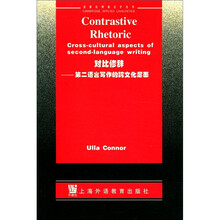剑桥应用语言学丛书:对比修辞(第二语言写作的跨文化层面)

目 录内容简介
Series editors' preface ix
Preface xi
I PRELIMINARIES; EARLY PHASES OF THE FIELD
1 Toward an extended definition of contrastive rhetoric Writing in a second language: anecdotal evidence about problems and solutions
Study of second language writing: the emergence of contrastive rhetoric
Aims, purposes, and outline of this book
Building a comprehensive theory of contrastive rhetoric
2 Contrastive rhetoric studies in applied linguistics Contrastive analysis, error analysis, and analysis of interlanguage
Development of contrastive rhetoric: parallel with contrastive analysis
International Englishes
New directions in contrastive rhetorical research in applied linguistics contexts
Summary
3 Historical evolution of contrastive rhetoric: from Kaplan's study to diversification in languages, genres, and authors
Origins of contrastive rhetoric
Arabic
Chinese
Japanese
Korean, German, Finnish, Spanish, and Czech
Summary
II INTERFACES WITH OTHER DISCIPLINES
4 Contrastive rhetoric and the field of rhetoric and composition
The role of rhetoric and composition in college education in the United States
Classical rhetoric
The expressionist approach
Contrastive rhetoric and the expressionist approach
Writing as a cognitive approach
The social constructivist approach
Summary
5 Contrastive rhetoric and text linguistics Brief overview of the history of text linguistics; definitions
Major schools of thought in text linguistics
Concepts and methods of text linguistics and their application to the study of writing
NORDTEXT and NORDWRITE text linguistic projects of student writing
Survey of contrastive rhetorical studies with a text linguistic emphasis
Summary
6 Writing as an activity embedded in a culture Definition of "culture"
Psychological investigations of culture and literacy
Anthropological study of culture and literacy
Educational study of culture and literacy Studies of culture and literacy conducted by applied
linguists
Summary
7 Contrastive rhetoric and translation studies
Development of theories of translation studies
Transfer in contrastive rhetoric and translation theory Issues in common: theories of "acceptability" and "adequacy"
in translation
Summary
8 Genre-specific studies in contrastive rhetoric The concept of genre
School writing
Academic writing
Professional writing
Learning academic writing in sociocognitive perspective as a dynamic activity
Summary
III IMPLICATIONS OF CONTRASTIVE RHETORIC
9 Methods of research in contrastive rhetoric
Guidance from studies of composition pedagogy
Methods of contrastive rhetorical research
Summary and implications
10 Conclusion: Implications and research directions
Implications from contrastive text studies
Implications from contrastive process-based writing
Implications from contrastive genre-specific research in EFL settings
Testing ESL/EFL writing in a cross-cultural setting
Research directions
References
Author index
Subject index
Preface xi
I PRELIMINARIES; EARLY PHASES OF THE FIELD
1 Toward an extended definition of contrastive rhetoric Writing in a second language: anecdotal evidence about problems and solutions
Study of second language writing: the emergence of contrastive rhetoric
Aims, purposes, and outline of this book
Building a comprehensive theory of contrastive rhetoric
2 Contrastive rhetoric studies in applied linguistics Contrastive analysis, error analysis, and analysis of interlanguage
Development of contrastive rhetoric: parallel with contrastive analysis
International Englishes
New directions in contrastive rhetorical research in applied linguistics contexts
Summary
3 Historical evolution of contrastive rhetoric: from Kaplan's study to diversification in languages, genres, and authors
Origins of contrastive rhetoric
Arabic
Chinese
Japanese
Korean, German, Finnish, Spanish, and Czech
Summary
II INTERFACES WITH OTHER DISCIPLINES
4 Contrastive rhetoric and the field of rhetoric and composition
The role of rhetoric and composition in college education in the United States
Classical rhetoric
The expressionist approach
Contrastive rhetoric and the expressionist approach
Writing as a cognitive approach
The social constructivist approach
Summary
5 Contrastive rhetoric and text linguistics Brief overview of the history of text linguistics; definitions
Major schools of thought in text linguistics
Concepts and methods of text linguistics and their application to the study of writing
NORDTEXT and NORDWRITE text linguistic projects of student writing
Survey of contrastive rhetorical studies with a text linguistic emphasis
Summary
6 Writing as an activity embedded in a culture Definition of "culture"
Psychological investigations of culture and literacy
Anthropological study of culture and literacy
Educational study of culture and literacy Studies of culture and literacy conducted by applied
linguists
Summary
7 Contrastive rhetoric and translation studies
Development of theories of translation studies
Transfer in contrastive rhetoric and translation theory Issues in common: theories of "acceptability" and "adequacy"
in translation
Summary
8 Genre-specific studies in contrastive rhetoric The concept of genre
School writing
Academic writing
Professional writing
Learning academic writing in sociocognitive perspective as a dynamic activity
Summary
III IMPLICATIONS OF CONTRASTIVE RHETORIC
9 Methods of research in contrastive rhetoric
Guidance from studies of composition pedagogy
Methods of contrastive rhetorical research
Summary and implications
10 Conclusion: Implications and research directions
Implications from contrastive text studies
Implications from contrastive process-based writing
Implications from contrastive genre-specific research in EFL settings
Testing ESL/EFL writing in a cross-cultural setting
Research directions
References
Author index
Subject index
目 录内容简介
《剑桥应用语言学丛书:对比修辞(第二语言写作的跨文化层面)》共分三大部分,每一部分下面又分出若干章节。作者在 第一部分对对比修辞的研究范围进行重新界定,简要描述了其他研究领域,诸如应用语言学、修辞学、篇章语言学、话语类型学等对对比修辞发展所产生的影响。第二部分中,作者详细论述了其他学科,如写作教学研究、篇章语言学、人类文化学以及翻译研究等领域给予对比修辞的影响与贡献。第三部分则讨论了对比修辞研究本身的重大启示意义。
比价列表
公众号、微信群
 缺书网
缺书网微信公众号
 扫码进群
扫码进群实时获取购书优惠






